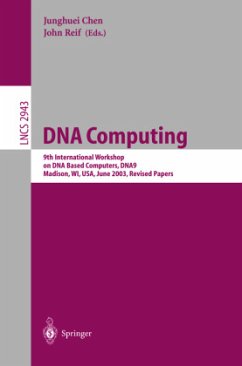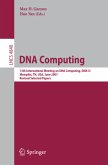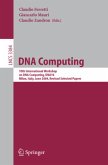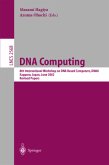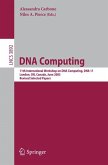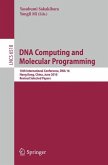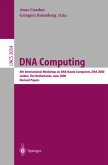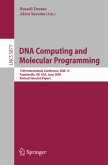This book constitutes the thoroughly refereed post-proceedings of the 9th International Workshop on DNA Based Computers, DNA9, held in Madison, Wisconsin, USA in June 2003.
The 22 revised full papers presented were carefully selected during two rounds of reviewing and improvement from initially 60 submissions. The papers are organized in topical sections on new experiments and tools, theory, computer simulation and sequence design, self-assembly and autonomous molecular computation, experimental solutions, and new computing models.
Biomolecular computing is an interdisciplinary ?eld that draws together mol- ular biology, DNA nanotechnology, chemistry, physics, computer science and mathematics. Theannualinternationalmeeting onDNA-based computationhas been an exciting forum where scientists of di?erent backgrounds who share a common interest in biomolecular computing can meet and discuss their latest results. The central goal of this conference is to bring together experimentalists and theoreticians whose insights can calibrate each others approaches. The 9th Annual International Meeting on DNA Based Computers was held during June 1 4, 2003 in the University of Wisconsin, Madison, USA. The meeting had 106 registered participants from 12 countries around the world. On the ?rst day of the meeting, we had three tutorials: the ?rst was on self-assembly of DNA nano structures which focused on the basic techniques of using designed DNA nano molecules to be self-assembled onto larger structures for computational purposes. This tutorial was given by Hao Yan of Duke U- versity. The second tutorial was given by Chengde Mao of Purdue University in which Dr. Mao presented basic DNA biochemistry that was designed for non experimentalists. The third tutorial was given by Max Garzon of the Univ- sity of Memphis. Dr. Garzon gave a lecture on computational complexity which was tailored for non-computer scientists. The next three days were for invited plenary lectures, and regular oral and poster presentations. Invited plenary l- turesweregivenbyHelenBermanofRutgersUniversity(USA),GiancarloMauri of the University of Milan (Italy), Guenter von Kiedrowski of Ruhr University (Germany), and Sorin Istrail of Celera/Applied Biosystems. Theorganizerssoughtto attractthemostsigni?cantrecentresearchwith the highestimpactonthedevelopmentofthediscipline.
Hinweis: Dieser Artikel kann nur an eine deutsche Lieferadresse ausgeliefert werden.
The 22 revised full papers presented were carefully selected during two rounds of reviewing and improvement from initially 60 submissions. The papers are organized in topical sections on new experiments and tools, theory, computer simulation and sequence design, self-assembly and autonomous molecular computation, experimental solutions, and new computing models.
Biomolecular computing is an interdisciplinary ?eld that draws together mol- ular biology, DNA nanotechnology, chemistry, physics, computer science and mathematics. Theannualinternationalmeeting onDNA-based computationhas been an exciting forum where scientists of di?erent backgrounds who share a common interest in biomolecular computing can meet and discuss their latest results. The central goal of this conference is to bring together experimentalists and theoreticians whose insights can calibrate each others approaches. The 9th Annual International Meeting on DNA Based Computers was held during June 1 4, 2003 in the University of Wisconsin, Madison, USA. The meeting had 106 registered participants from 12 countries around the world. On the ?rst day of the meeting, we had three tutorials: the ?rst was on self-assembly of DNA nano structures which focused on the basic techniques of using designed DNA nano molecules to be self-assembled onto larger structures for computational purposes. This tutorial was given by Hao Yan of Duke U- versity. The second tutorial was given by Chengde Mao of Purdue University in which Dr. Mao presented basic DNA biochemistry that was designed for non experimentalists. The third tutorial was given by Max Garzon of the Univ- sity of Memphis. Dr. Garzon gave a lecture on computational complexity which was tailored for non-computer scientists. The next three days were for invited plenary lectures, and regular oral and poster presentations. Invited plenary l- turesweregivenbyHelenBermanofRutgersUniversity(USA),GiancarloMauri of the University of Milan (Italy), Guenter von Kiedrowski of Ruhr University (Germany), and Sorin Istrail of Celera/Applied Biosystems. Theorganizerssoughtto attractthemostsigni?cantrecentresearchwith the highestimpactonthedevelopmentofthediscipline.
Hinweis: Dieser Artikel kann nur an eine deutsche Lieferadresse ausgeliefert werden.

